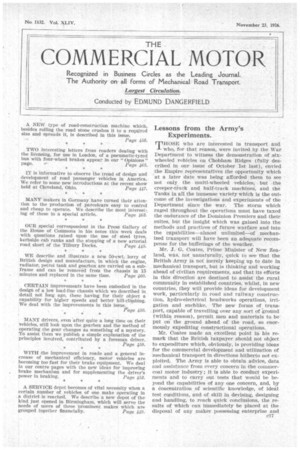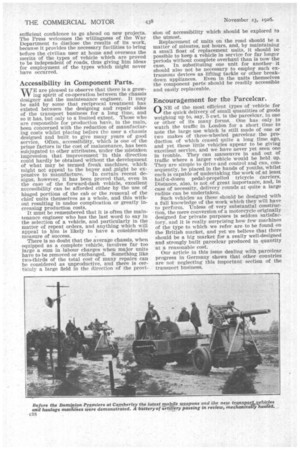Lessons from the Army's Experiments.
Page 39

Page 40

If you've noticed an error in this article please click here to report it so we can fix it.
THOSE who are interested in transport and who, for that reason, were invited by the War Department to witness the demonstration of .sixwheeled vehicles on Chobham Ridges (fully described in our issue of October 1st last), envied the Empire representatives the opportunity which at a later date was being afforded them to see not only the multi-wheeled vehicles, but the creeper-tiaCk and half-track machines, and the Tanks in all the immense variety which is the outcome of the investigations and experiments of the Department since the war. The storm which raged throughout the operations must have taxed the endurance of the Dominion Premiers and their suites, but the insight which was gained into the methods and practices of future warfare and into the capabilities—almost unlimited—of mechanized transport will have been an adequate recompense for the buffetings of the weather.
Mr. J. G. Coates, Prime Minister of New Zealand, was, not unnaturally, quick to see that the British Army is not merely keeping up to date In mechanical transport, but is thinking and working ahead of civilian requirements, and that its efforts in this direction are destined to assist the rural community in established countries, whilst, in new countries, they will provide ideas for development work, particularly in road and railway construction, hydro-electrical headvvorks operations, irrigation and suchlike. The new forms of trans, port, capable of travelling over any sort of -ground (within reason), permit men and materials to be put on the ground ahead of the road, so enormously expediting constructional operations.
Mr. Coates made an excellent point in his remark that the British taxpayer should not object to expenditure which, obviously, is providing ideas for the commercial development and utilization of mechanical transport in directions hitherto not exploited. The Army is able to obtain advice, data and assistance from every concern in the conmiercoal motor industry ; it is able to conduct experiments and to carry out tests that would be beyond the capabilities of any one concern, and, by a eoncentration of scientific knowledge, of ideal test conditions, and of skill in devising, designing and handling, to reach quick conclusions, the results of which can immediately be placed at the disposal of any maker possessing enterprise and sufficient confidence to go ahead on new projects. The Press welcomes the willingness of the War Department to disclose the results of its work, because it provides the necessary facilities to bring before the civilian user at home and overseas the merits of the types of vehicle which are proved to be independent of roads, thus giving him ideas for employment of the types which might never have occurred.
Accessibility in Component Parts.
WE are pleased to observe that there is a growing spirit of co-operation between the chassis designer and the maintenance engineer. It may be said by some that reciprocal treatment has existed between the designing and repair sides of the transport business for a long time, and so it has, but only to a limited extent. Those who are responsible for production have, in the main, been concerned with the reduction of manufacturing costs whilst placing before the user a chassis designed and built to give many years of good service. Often, accessibility, which is one of the prime factors in' the cost of maintenance, has been subjugated to other attributes, under the mistaken impression that improvement in this direction could hardly be obtained without the development of what may be termed freak machines, which might not appeal to the buyer and .might be expensive to manufacture. In certain recent designs, however, it has been proved that, even in the case of the forward-dash vehicle, excellent accessibility can be afforded either by the use of hinged portions of the cab or the removal of the chief units themselves as a whole, and this without resulting in undue complication or greatly increasing production costs.
It must be remembered that it is often the maintenance engineer who has the last word to say in the selection of a vehicle, and particularly in the matter of repeat orders, and anything which will appeal to him is likely to have a considerable measure of success. .
There is no doubt that the average chassis, when equipped as a complete vehicle, involves far too large a sum in labour charges when major units have to be removed or exchanged. Something like two-thirds of the total cost of many repairs can be considered as unproductive, and there is certhinly a large field in the direction of the provi sion of accessibility which should be explored to the utmost.
Replacement of units on the road should be a matter of minutes, not hours, and, by maintaining a small float of replacement units, it should be possible to keep a vehicle in service for far longer periods without complete overhaul than is now the case. In substituting one unit for another it should also not be necessary to employ such extraneous devices as lifting tackle or other breakdown appliances. Even in the units themselves the component parts should be readily accessible and easily replaceable.
Encouragement for the Parcelcar.
ONE of the most efficient types of vehicle for the quick delivery of small quantities of goods weighing up to, say, 5 cwt. is the parcelcar, in one or other of its many forms'. One has only to watch the traffic in London for a short time to note the large use which is still made of one or two makes of three-wheeled parcelcar the production of which ceased quite a long time ago, and yet these little vehicles appear to be giving excellent service, and we have never yet seen one in trouble. They can manceuvre in and out of traffic where a larger vehicle would be held up. They are simple to drive and control and can, consequently, be placed In the hands of youths, whilst each is capable of undertaking the work of at least half-a-dozen pedal-propelled tricycle Carriers. Distance, also, is not of great importance, and, in case of necessity, delivery rounds at quite a large radius can be undertaken.
Such vehicles as these should be designed with a full knowledge of the work which they will have to perform. `Unless of very substantial construction, the mere conversion of a motorcycle originally designed for private purposes is seldom satisfactory. and it Is really surprising how few machines of the type to which we refer are to be found on the British market, and yet we believe that there should be a big market for a really well-designed and strongly built parcelcar produced in quantity at a reasonable cost.
Our article in this issue dealing with parcelcar progress in Germany shows that other countries are not neglecting this important section of the transport business.












































































































